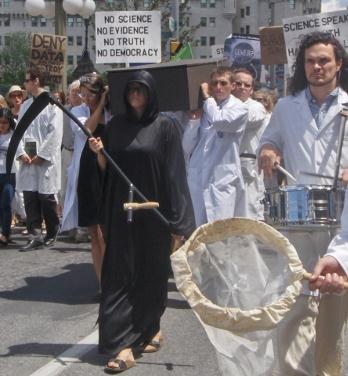Thousands of scientists and allies marched to Parliament Hill from the Ottawa Conference Centre July 10 to protest the Harper government’s sweeping cuts to scientific programs.
The death-of-evidence rally was modelled after a funeral procession; many protesters were dressed in lab coats, scientific garb or black attire. The marchers were led by a woman dressed as the Grim Reaper, and morose pallbearers carried a coffin symbolizing the death of scientific evidence.
Protest organizers say the federal government’s omnibus bill, C-38, has decimated funding to or completely eliminated vital programs, including the Polar Environment Atmospheric Research Laboratory and the Experimental Lakes Area (ELA) among many others.
Departmental cuts to Fisheries and Oceans Canada, Environment Canada and the Natural Sciences and Engineering Research Council of Canada were cited by many attendees as the reason they chose to join the congregation.
In addition, demonstrators said a new policy limiting access to federal government scientists is essentially “muzzling” Canada’s scientific community.
Rally speakers included Ted Hsu, a physicist and the Liberal MP for Kingston and the Islands; Jeff Hutchings, a professor of biology at Dalhousie University and president of the Canadian Society for Ecology and Evolution; and Maude Barlow, national chairperson of the Council of Canadians.
Vance Trudeau, a professor at the University of Ottawa and president of the North American Society for Comparative Endocrinology, said the funding cuts will affect the health of all Canadians and the Harper government is utilizing the unseemly tactic of propaganda.
“The tendency to use only data and evidence that you like is the misuse of information for alternative purposes. The definition . . . is known as propaganda,” Trudeau said.
Several speakers emphasized the funding cuts to the ELA as an egregious loss for worldwide scientific research. Founded in 1968, the ELA is a network of 58 lakes north of Kenora that has hosted many research initiatives, including studies on acid rain, the negative impact of phosphorus in waterways and the improvement of hydroelectricity. The ELA’s $2 million annual federal funding is expected to cease in April 2013.
PhD student Diane Orihel is spearheading the effort to save the ELA and delivered a eulogy for her beloved research site, calling the ELA a decorated soldier who may lose its final battle.
“Today, we mourn the Experimental Lakes, but moreover, we mourn the blindfold of ignorance imposed upon our once great country with fear and trembling as we enter a 2+2=5 universe,” Orihel said.
Barlow said the Harper government isn’t closing down the ELA because the researchers employed at the facility aren’t doing a good job; she said it is because ELA’s scientists are doing their jobs too well and the Harper government would rather pave the way for big industry to pollute freely.
“Part of their mandate is to tell the story about what the extractive industries in Canada, particularly the tar sands and mining, are doing to our fresh water,” she said.
“So what do you do if you want to kill the message? Just kill the messenger. Harper, the water of Canada does not belong to you. It belongs to all Canadians. It belongs to the ecosystem. It belongs to our future. And we will not let it go on our watch.”
Hsu, the Liberal science and technology critic, spoke of his scientific background and underscored the importance of factually based research.
“I am a scientist, and I believe that for good government, slogans and ideology are never a substitute for facts,” he said.
“I believe that science is powerful because it accepts criticism, and I believe that a government that can accept criticism and embrace inconvenient facts will be a more honest government and make stronger decisions for a stronger Canada.”
Hsu closed out the rally by imploring concerned Canadians to show their distaste for the funding cuts by hitting the Conservatives where it counts: the ballot box. “I am calling on you to create the pressure that really matters. Go out, meet voters, find out why people vote the way they do and help move people to vote.”
A statement from the office of Gary Goodyear, minister of state for science and technology, said that the Harper government has moved to make “historic investments in science, technology and research to create jobs, grow our economy and improve the quality of life for Canadians.
“Our investments are enabling Canadian scientists in universities, colleges, businesses and other organizations to help secure Canada’s prosperity today and into the future,” Goodyear wrote.
Scientific investments found in the 2012 budget include $60 million for Genome Canada and $17 million over two years to develop alternatives to isotope production.
Statistics Canada reported that for the fiscal 2010/11 year, federal government spending on science and technology was $11.7 billion. Exact figures for the coming fiscal year remain unclear.


 Why you can trust Xtra
Why you can trust Xtra


